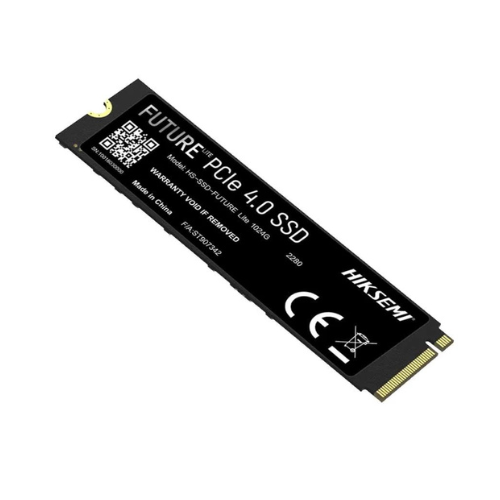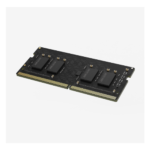

HIKSEMI DDR4 8GB 2666MHZ HSC408S26Z1/HIKE
OMR19.900
Features:
- DDR4 Technology
- Capacity
- Speed
- Form Factor
- Compatibility.
- Manufacturer
- Quality and Reliability
- CAS Latency
- Voltage
Additional Features:
- DDR4 Technology: It utilizes DDR4 (Double Data Rate 4) technology, which offers improved performance and energy efficiency compared to its predecessors like DDR3.
- Capacity: The module has a capacity of 8GB, which refers to the amount of data it can store and retrieve at any given time. This capacity is suitable for many mainstream computing tasks, including gaming, multimedia, and office applications.
- Speed: The memory module operates at a speed of 2666MHz (megahertz), indicating the rate at which data can be transferred to and from the memory. Higher speeds generally result in better overall system performance.
- Form Factor: The form factor of the module is not explicitly mentioned in the provided information. However, DDR4 memory modules typically adhere to industry-standard form factors such as DIMM (Dual In-Line Memory Module) for desktops and SODIMM (Small Outline DIMM) for laptops.
- Compatibility: It is important to ensure compatibility with your system’s motherboard before purchasing or installing the memory module. Compatibility factors include the module’s form factor, memory type (e.g., DDR4), speed, and capacity.
- Manufacturer: The memory module is manufactured by Hiksemi, a company known for producing DRAM (Dynamic Random Access Memory) modules and other memory-related products.
- Quality and Reliability: Like other reputable memory manufacturers, Hiksemi likely adheres to industry standards for quality and reliability in its products. This ensures stable performance and longevity under normal operating conditions.
- CAS Latency: The CAS (Column Address Strobe) latency, which represents the delay between the moment a memory controller tells the memory module to access a particular column of data and the moment the data is available, is not specified in the provided information. However, it’s an important consideration for memory performance.
- Voltage: DDR4 memory typically operates at a lower voltage compared to previous DDR generations, contributing to energy efficiency and reduced heat generation
Shipping & Delivery
-
Within Muscat
Our courier will deliver to the specified address
Delivery Within 24 Hours
-
Out Of Muscat
Carrier company
Delivery within 1-3 Days
-
Warranty Terms
Loading...
Hiksemi DDR4 8GB 2666MHz HSC408S26Z1/HIKE Overview Product Overview • size 18pxFeatures n nDDR4 Technology nCapacity nSpeed nForm Factor nCompatibility. nManufacturer nQuality and Reliability nCAS Latency nVoltage n nAdditional Features n nDDR4 Technology It utilizes DDR4 Double Data Rate 4 technology, which offers improved performance and energy efficiency compared to its predecessors like DDR3. nCapacity The module has a capacity of 8GB, which refers to the amount of data it can store and retrieve at any given time. This capacity is suitable for many mainstream computing tasks, including gaming, multimedia, and office applications. nSpeed The memory module operates at a speed of 2666MHz megahertz, indicating the rate at which data can be transferred to and from the memory. Higher speeds generally result in better overall system performance. nForm Factor The form factor of the module is not explicitly mentioned in the provided information. However, DDR4 memory modules typically adhere to industry-standard form factors such as DIMM Dual In-Line Memory Module for desktops and SODIMM Small Outline DIMM for laptops. nCompatibility It is important to ensure compatibility with your systems motherboard before purchasing or installing the memory module. Compatibility factors include the modules form factor, memory type e.g., DDR4, speed, and capacity. nManufacturer The memory module is manufactured by Hiksemi, a company known for producing DRAM Dynamic Random Access Memory modules and other memory-related products. nQuality and Reliability Like other reputable memory manufacturers, Hiksemi likely adheres to industry standards for quality and reliability in its products. This ensures stable performance and longevity under normal operating conditions. nCAS Latency The CAS Column Address Strobe latency, which represents the delay between the moment a memory controller tells the memory module to access a particular column of data and the moment the data is available, is not specified in the provided information. However, its an important consideration for memory performance. nVoltage DDR4 memory typically operates at a lower voltage compared to previous DDR generations, contributing to energy efficiency and reduced heat generation n High-quality materials and latest technology. Designed for durability and efficiency. Perfect for professionals and home users. Trusted by thousands of customers worldwide. Order now and get fast delivery High-quality materials and latest technology. Designed for durability and efficiency. Perfect for professionals and home users. Trusted by thousands of customers worldwide. Order now and get fast delivery Why Choose This Product? ✔ High-quality materials and design. ✔ Built for performance and durability. ✔ Trusted by thousands of satisfied customers. ✔ Perfect for home and professional use. ✔ Fast delivery and great customer support. Key Features ✔ High-quality materials and latest technology. ✔ Designed for durability and efficiency. ✔ Ideal for professionals and home users. ✔ Trusted by thousands of customers worldwide. ✔ Order now and get fast delivery!
Only logged in customers who have purchased this product may leave a review.







Reviews
Clear filtersThere are no reviews yet.